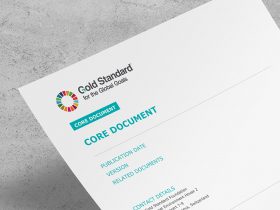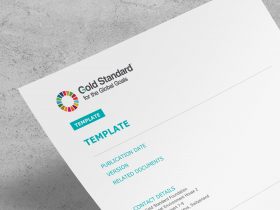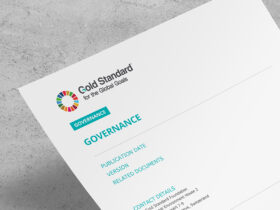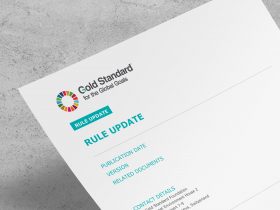Governments will be able to certify the impact of their emission reduction policies through Gold Standard, with the launch of innovative new Policy Requirements and Procedures. This initiative, currently in pilot phase, provides a route for carbon finance to support large scale climate action by allowing certification and credit issuance for emission reductions achieved through policies or regulations. The new Policy Requirements and Procedures from Gold Standard offer a financial mechanism to incentivise the introduction of new climate policies, directly leading to greenhouse gas reductions or removals. This approach works alongside other requirements under Gold Standard for the Global Goals, ensuring comprehensive safeguarding, sustainable development, and stakeholder consultation. Through these pilots Gold Standard will certify the impacts on climate and sustainable development resulting from new policies or regulations, especially in energy and land use sectors. These certified impacts can generate credits, which are expected to be authorised as Internationally Transferred Mitigation Outcomes (ITMOs) under Article 6 of the Paris Agreement. ...
Gold Standard and the International Rice Research Institute have released a new resource hub designed to encourage and support the development of sustainable rice production activities in Vietnam and around the world by simplifying rice producers’ access to new income streams from carbon finance. The new ‘Rice Sustainability Hub’ is now available to access on the Gold Standard for the Global Goals website. In 2022, Gold Standard entered a partnership with the International Rice Research Institute (IRRI) and the Australian Department of Foreign Affairs and Trade (DFAT) through the Business Partnerships Platform (BPP) with the aim of scaling carbon market access for sustainable rice producers in Vietnam. The Rice Sustainability Hub developed through the partnership is the first of its kind for the rice sector in Vietnam. The Rice Sustainability Hub is designed to group the resources and tools Project Developers and Validation and Verification Bodies (VVBs) need to effectively support the development of sustainable rice projects under the Gold ...
Gold Standard are very pleased to announce a major step towards the digitisation of the Standard and streamlining of the certification process today. The new Gold Standard digital SDG Impact Tool for project developers and other stakeholders, and a complementary open access SDG Impact Dashboard, were released today. The new Tool streamlines the reporting, quantification, verification, and certification of the sustainable development impact of Gold Standard projects, while the Dashboard showcases the climate and SDG impact of projects through interactive charts and maps – enhancing data transparency and informing the decision of project supporters. Digital SDG Impact Tool Following the soft launch of the digital SDG Impact Tool in Q4 2023, we received constructive stakeholder feedback, and have been working to improve and enhance the tool, ensuring it meets the users’ needs and delivers on its core purpose. We are very pleased to announce the full launch of the tool today. This new tool is part of the work to ...
Cows release methane (CH4) as a result of the digestion of feed materials in the rumen, one of the four stomach chambers of ruminant livestock. Fermentation in the rumen generates hydrogen as a result of the feed degradation by microorganisms present in the rumen. The animals must remove the produced hydrogen. One of the ways to reduce hydrogen in the rumen is the production of methane which is released by respiration and eructation into the atmosphere. These emissions are called enteric emissions. This methodology quantifies the reduction of methane emissions from enteric fermentation in beef cattle, as well as impacts on emissions during manure handling. It focuses on the application of feed supplements to reduce enteric methane production in the rumen of livestock. The methodology provides two approaches for quantification of emissions from enteric fermentation. Approach 1 requires on-site measurements whereas Approach 2 applies regression models or IPCC Tier 2 equations integrating data from peer-reviewed publications. New models may also be used if ...
Traditional rice cultivation practices are both water intensive and the second largest contributor to agricultural emissions after livestock. Methane is produced when organic matter decomposes in flooded rice fields without access to oxygen. The new methodology is applicable to measures that reduce the emission of methane by: The methodology is applicable to measures that reduce anaerobic decomposition of organic matter in rice-cropping soils. Such measures include changing the water regime during the cultivation period from continuously to intermittently flooded conditions and/or a shortened period of flooded conditions, using the alternate wetting and drying method, adopting aerobic rice cultivation methods, and switching from transplanted to direct-seeded rice (DSR). This methodology can be applied to large and small-scale or micro-scale projects or PoAs. The methodology is adapted from the small-scale CDM methodology AMS-III.AU – Methane emission reduction by adjusted water management practice in rice cultivation – Version 4.0. This methodology has been revised in accordance with the recent IPCC guidelines (Chapter 5.5 ...
This document describes the process for reviewing, approving new methodology & methodology tool, revisions and updates to an approved methodology and methodology tool and addressing clarifications on approved methodology and tools, followed under the GS4GG. Gold Standard has revamped the methodology development procedure. Updates and new requirements including following changes. ...
The aim of the validation and verification standard is to provide a roadmap for more efficient and consistent project assessments. This document provides the requirements and procedures for Gold Standard Validation and Verification Bodies (GS VVBs) and Certification Bodies (CBs) to successfully carry out validation and verification for standalone project activities and Programme of Activities (PoAs) under Gold Standard for the Global Goals (GS4GG) and all earlier versions of Gold Standard. Benefits of the Validation and Verification Standard The standard increases clarity of the minimum requirements for validation and verification activities under Gold Standard for the Global Goals (GS4GG), making it easier, for example: It also aids Gold Standard in general, to improve the quality and consistency of GS4GG validation and verification activities performed by different teams and VVBs, and to reduce design and performance review timelines. ...
Enabling a shift to less energy intensive modes of transport in urban environments supports decarbonisation of the transport sector, reduces air pollution and can enable better city living. This methodology applies to project activities that implement infrastructure in urban areas (such as new bicycle lanes, transport sharing programmes, bicycle parking) that support a shift to less energy intensive modes of transport such as mechanical bicycles, tricycles, e-bikes, or e-tricycles. The small-scale methodology builds upon the CDM methodology AMS.III.BM. and has approved by Gold Standard to also include eligibility for new and/or the expansion of existing passenger transportation services based on tricycles and e-scooters. It is developed in association with Micromobility Research Partnership™. This methodology applies to project activities that shift the mode of transport of urban passengers to mechanical bicycles, tricycles, e-bikes, e-scooters, or e-tricycles, by implementing related infrastructure in an urban area such as bicycle lanes, bicycle and e-scooter sharing programmes (through dock less bicycles or e-scooter sharing stations) and bicycle ...
This document defines the rights, obligations, roles and responsibilities of a GS-VVB in the Gold Standard Certification Process. It is to be signed by any organisation that is or applies to become a Gold Standard Validation and Verification Body (“GS-VVB”) returned to vvb@goldstandard.org. ...
The need to undertake climate action is growing ever more urgent, with temperatures already registering 1.30C, a 50% reduction in emissions globally is required by 2030, including a cut of methane emissions by a third. The next few years are therefore critical, and we need near-term milestones and actions to help us get on track for long-term targets.To support this shift and urgent need, we have made some important revisions to our standard development priorities. This document provides details of these changes as well as our plans to continue maximizing market opportunities, mitigating risk, ensuring integrity, and delivering a clearer, more streamlined, and simpler application of our standard. Summary of key updates includes: 1 – MARKET DRIVEN STANDARD DEVELOPMENT Alignment with key emerging market policies, schemes, and requirements to maximise market opportunities for projects as well as mitigate the risk of inadvertently undermining government efforts. 2 – GOLD STANDARD FOR THE GLOBAL GOALS – REVIEW + UPDATES To conform with ...
RULE UPDATES APPLICATION OF TPDDTEC METHODOLOGY TO SAFE WATER SUPPLY PROJECTS This rule update provides an approach to calculate the parameter value for the quantity of fuel to treat 1 litre of water using baseline/project technologies in cases where advanced technologies, such as improved cookstoves, are used in the baseline. COVID-19 INTERIM MEASURES Current interim measures have been extended from 30/06/2022 to 31/12/2022 only for those projects which are located in a place where COVID-19 related restrictions still exist. To apply these interim measures the project developer must provide evidence to confirm that regulations or other restrictions indeed prohibited the project from complying with Gold Standard for the Global Goal requirements and/or implementing the registered monitoring plan. As this is an extension to the previous rule update, no grace period applies. IMPORTANT DATE: Deviations already approved with an earlier version of the COVID-19 interim measures will end on 12 September 2022. After this date, the project developer shall demonstrate compliance with GS4GG requirements and/or a registered monitoring plan for ...
NEW TEMPLATE The Gold Standard Secretariat receives numerous queries, questions and/or concerns from various stakeholders daily. This form is for any entity seeking clarification or interpretation of Gold Standard for the Global Goals and provides a workflow to formalise the review process and to provide resolutions in a transparent and timely manner. Resolved clarification requests deemed useful to other stakeholders will be made publicly available on the Gold Standard for the Global Goals website. ...
CONSULTATION Revised methodology for project activities that recover and use methane from manure and agricultural waste This methodology applies to activities that recover and use methane from manure and agricultural waste that would otherwise decay anaerobically and emit methane into the atmosphere. This methodology will displace the application of Technologies and Practices to Displace Decentralised Thermal Energy Consumption (TPDDTEC) v3.1 methodology for biogas generation and thermal energy project activities. It has been consolidated to integrate both animal waste management systems (AWMS) and thermal application of biogas to provide a one-stop solution for such projects. HOW TO SUBMIT FEEDBACK We are seeking general comments on the methodology and whether it’s fit for purpose as well as specific feedback on whether a simplified methodology should be developed for micro/small scale project activities. Please submit all feedback and questions via email to Anshika Gupta by 08 August 2022. ...
METHODOLOGY Methodology developed to support the origination of high-impact microscale clean cooking projects This methodology was first published in 2013 with the explicit intention to lower transaction costs for microscale activities seeking carbon finance to support improved cookstove technologies. Taking into consideration feedback from the consultation held in April, we are pleased to publish a revised methodology that now aligns with latest science, introduces further efficiencies for project developers, provides more clarity and promotes consistency between our methodologies. This methodology is published alongside an Emission Reduction Calculation Tool and baseline/project survey questionnaire template. Key changes include: Expansion to charcoal stove projects Revision of the requirements to calculate project cookstove efficiency Inclusion of new data, parameters, and related requirements, to ensure consistency across all improved cookstoves/distributed technology methodologies Simplified monitoring approach Updates to the sample survey questionnaires ...
NEW METHODOLOGY Tech-based carbon removal and storage in recycled concrete Currently, demolished concrete is crushed into concrete aggregate before it is either used as a substitute to gravel and sand or sent to landfill. This new tech-based carbon removal methodology, developed by neustark, facilitates CO2 sequestration in demolished concrete using either direct or indirect mineral carbonation before it enters downstream processes. ...
NEW METHODOLOGY Catalysing nature-based sequestration from industrial waste This new Soil Organic Carbon (SOC) Activity Module developed by Soilfood Oy allows European-based pulp and paper manufacturing to reduce waste and remove carbon from the atmosphere by recycling the mill sludge from industrial operations. What would otherwise go to landfill or be incinerated is used to enhance soil organic matter in agriculture systems, which beyond biologic sequestration, helps improve soil quality, increase soil PH, and provide nutrients for better productivity. ...
REQUIREMENTS Updated to ensure consistency in process and improve response times to deviation requests The requirements, procedures and template for the deviation process have been updated to clarify the process and speed up responses to deviation requests. The path for requesting reconsideration of a deviation decisions has also been clarified. Related Documents Deviation Request Form v.5.0 3.05.2022 ...
REQUIREMENTS Stakeholder consultation process streamlined to make requirements more user friendly for project developers and VVBs Stakeholder consultations and meaningful engagement with those who may be affected by a project is an essential element for ensuring project success. Key updates include: More cohesive requirements for Programme of Activities (PoAs) to reduce time spent navigating multiple documents Reduction in the mandatory duration of Stakeholder Feedback Round from 60 to 30 days New requirements for engagement of an expert stakeholder Revision to the submission timeline for stakeholder consultation reports We have also added a new case study to the stakeholder consultation guidelines to showcase how the requirements work in practice and updated the relevant related resources. Related Documents PoA Design Consultation Report v.2.0 5.05.2022 Stakeholder consultation and engagement Guidelines v.2.0 4.05.2022 Stakeholder Consultation Report v.2.0 5.05.2022 ...
REQUIREMENTS More clarity on requirements for PoAs, scope expansion into Land Use & Forestry projects and simplifications to PoA project cycle procedures Programme of Activities enable replicable projects access to carbon finance through coordinated implementation, supporting high-impact projects that may have previously struggled to finance activities due to project size and associated transaction costs. Key updates include: New PoA hierarchy defined and corresponding rules and requirements established Scope expansion to include requirements and procedures for Land Use and Forestry projects Simplifications to the PoA project certification cycle and inclusion of new PoAs ...
REQUIREMENTS A step closer to supporting the creation and transfer of Internationally Transferred Mitigation Outcomes (ITMOs) under Article 6. The GHG Emissions Reduction and Sequestration Product Requirementswhich provides the specific rules for projects seeking issuance of products (i.e., GS VERs, GS CERs and PERs) has been updated to: These updates have been made based on outputs from COP26, feedback from multiple consultations, and participation within working groups including the Voluntary Carbon Market Integrity Initiative and our own Working Group on Article 6 set up to ensure environmental integrity and that carbon finance continues to flow where it has the greatest impact. Key changes include: If you have any feedback or would like to speak with Gold Standard directly about Article 6 activities, please email Kavya Bajaj. WEBINARS PLAYBACK ARTICLE 6 WEBINAR SERIES – session 1Authorisations and adjustments under Article 6:What you need to know, and what is still unknown RECORDED 22 February 2022 ARTICLE 6 WEBINAR SERIES – session 2From text to trade: How is Article 6 guidance being implemented on ...
New template toguide the project developers in evaluating the eligibility of their projects and compiling all necessary information for a fast and successful preliminary review process. The preliminary review process gives an early indication to project developers, before resources are committed, of the eligibility of a project. This step is not a certification decision, but it helps project developers close project design gaps early in the process. This new template provides more structured guidance to streamline this process. It is to be submitted along with the Project Design Document, the stakeholder consultation report, and all other documents required for preliminary review. BENEFITS Streamlined preliminary review process Guidance on project eligibility and relevant requirements Concrete questions in checklist format guide project developers Project design gaps are identified early in the process Integrated decision-making to keep communications together ...
New annex provides an alternative and less time-consuming method to monitor and calculate project fuel consumption and savings. The new SGDL model is based on code/software that has been developed by the Sea Grant Design Laboratory (SGDL) at the Massachusetts Institute of Technology (MIT). It uses regression models based on a ship’s physical characteristics and hydrodynamics, together with its speed, loading condition, and resistance traveling through the water, to calculate the project fuel consumption and savings. The code/software has been made publicly available at no cost via the MIT Sea Grant website. ...
New approach to quantify GHG impact from metered cooking devices through direct measurement of energy or fuel This new methodology applies to modern energy cooking appliances that directly measure in real-time the amount of energy or fuel used in the project scenario. This includes, but not restricted to, LPG, electric and biogas metered cookstoves, and bio-ethanol cookstoves. The methodology was developed and submitted by ClimateCare and Modern Energy Cooking Services (MECS) and aims to use the data capabilities of modern energy cooking appliances to scale carbon finance for clean cooking solutions. ...
The COVID-19 Interim Measures will be further extended by six months to 30 June 2022. The interim measures will also be updated to include new requirements and procedures for physical stakeholder meetings and Stakeholder Feedback Rounds that are delayed due to the pandemic. These measures will be updated and released before the end of the year. ...
New SDG Impact Tool to more efficiently monitor, quantify and verify a project’s contributions to the SDGs, is ready for use. The Gold Standard SDG Impact Tool makes it easier and less expensive for project developers to deliver more positive impact and measure those impacts quantitively, ensuring specific and credible impact claims. Built on principles formed in the SDG Tool Guidance and piloted in the first half of 2021, this excel-based tool provides a standardised template to clearly and transparently monitor SDG impact alongside carbon reductions — simplifying the process, minimising the cost of Monitoring, Reporting and Verification (MRV), whilst enabling consistent and meaningful contributions to the SDGs. FEATURES Indicators map to relevant SDG targets based on published literature to ensure outcomes are real and measurable Built-in guidance helps to select parameters that will make the most difference to project beneficiaries Supporting resources are designed to make implementation clearer and more streamlined Reference values help auditors more efficiently assess monitoring reports and safeguard against over-claiming To support the use of this tool, we ...
NEW METHODOLOGY The Gold Standard has developed a methodology for the activities that involve recovery and use of methane from manure and agricultural wastes that would be decaying anaerobically, emitting methane to the atmosphere in the absence of the implemented activity. This methodology replaces the application of “Technologies and Practices to Displace Decentralized Thermal Energy Consumption (TPDDTEC) v3.1” methodology for biogas generation and application for thermal energy project activities. The methodology presents an integrated methodology for AWMS and thermal application of captured biogas with multiple options. ...











